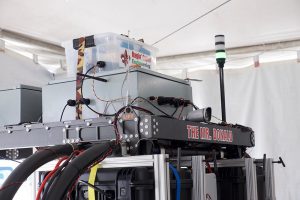 In 1977, George Lucas’ Star Wars introduced us to R2-D2, an intelligent bot that embodied contemporary assistive robotics: he might anticipate needs and carry out a variety of jobs with minimal direction. Nearly 40 years later on, assisted robotics provide game-changing benefits to production, and we have actually been canvassing Australian producers to find out how robots can help them overcome current difficulties. Through a series of workshops kept in Melbourne and Brisbane, we examined what producers want and where they envisage utilizing robotics will assist to resolve current problems. Here, I provide Australian manufacturing’s wish-list for robotics.
In 1977, George Lucas’ Star Wars introduced us to R2-D2, an intelligent bot that embodied contemporary assistive robotics: he might anticipate needs and carry out a variety of jobs with minimal direction. Nearly 40 years later on, assisted robotics provide game-changing benefits to production, and we have actually been canvassing Australian producers to find out how robots can help them overcome current difficulties. Through a series of workshops kept in Melbourne and Brisbane, we examined what producers want and where they envisage utilizing robotics will assist to resolve current problems. Here, I provide Australian manufacturing’s wish-list for robotics.
Robots to make the work environment more secure
Australian producers want to utilize robots to orient, lift and manipulate components that do not need the physical capacity of equipment such as the slab crane so that employees can assemble them with greater accuracy in manufacturing lines.
The significant goal is to reduce occupational health and safety hazards, settlement claims and wasted time from worker absenteeism – though enhanced item quality is frequently a bonus.
Robotics have actually developed potential to handle jobs that individuals don’t wish to do and shouldn’t be doing, such as harmful or highly recurring jobs that make employees vulnerable to repetitive-stress injuries. In 2011, Dulux Group set up a robotic system in a Victorian factory to assist workers handling heavy bags of combustible powder, often a job too small for drake low loaders, which posed a possible respiratory hazard for employees.
The robotic system removed occupational health and safety events and allowed nine workers to be redeployed from a possibly dangerous and uneasy working environment.
Robots to assist increases in productivity
Australian makers want assistive robotics as an active extra set of hands to increase employee production output. Robotics have been revealed to be effective in increasing performance in industries differing from spray painting, welding, trailer manufacturing to plastic part manufacture.
A commercial robotic from automation innovation business ABB Australia, set up in 2008 has improved efficiency and turnover for Brisbane-based Drake Trailers, among Australia’s biggest producers of low-loader and specialist big scale trailers.
The ABB robot helped Drake Trailers lower unit expense while achieving better surface and repeatability. The increase in productivity at the family-owned business translated into a yearly turnover of $45-50 million AUS, while staff numbers doubled within five years.
The spray painting department of Melbourne-based Hilustre Coatings deals with a wide range of items, consisting of kitchen cabinets, display panels, shop fittings and automobile parts. The variation in size, shape and product diversity of the one million products processed each year indicated that a robot had to be capable of fast and simple transitions to handle the requirements of the facility. The robotic process set up permitted Hilustre to increase effectiveness by about 40%, and reduce the amount of paint per run while increasing the quality and consistency. Lower waste of paint and solvent has enhanced economy of the operation.
Improving item quality utilizing robots
Assistive robotics offer lots of opportunity for improving the quality of made items. Australian manufacturers are keen to see this take place through use of actual time and virtual guidance to enhance quality and reduce item rejection rates and waste:
- by reducing time needed for inspection and accreditation through time capture of quality and compliance data throughout manufacture
- by enhancing item quality by lowering misalignment and inaccurate assembly of elements.
